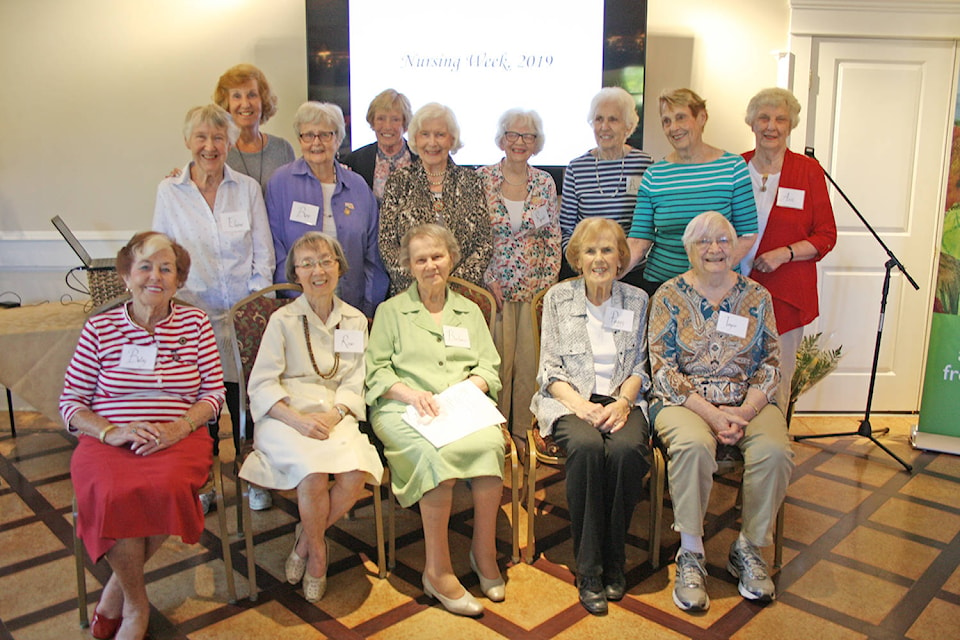Sarah Doughty knew there were at least a few more retired nurses living at the Carlton House seniors residence with her in Oak Bay.
But she didn’t realize 15 of the 90 residents were nurses. All of them women.
“We were surprised and we wanted to honour the nurses living here for National Nursing Week,” said Nicole Peers, Carlton’s leisure services coordinator.
READ MORE: Carlton House knitters send warmth to Our Place
“It’s still out there you know, ‘nursing,’” said Doughty, in recounting the profession. Between Doughty, Rose and Peggy Etchell, three different stories emerged. All finished with the same conclusion, upon retirement they were drawn to Victoria and Oak Bay.
Recently, Doughty underwent cardioversion, when electric shocks are used to stabilize a heart rhythm.
“It was a bit of a scare, getting the shock, and I felt the hand of the nurse on my shoulder and he said, ‘I’m here,’” said Doughty. “That’s nursing.”
Doughty first trained in nursing at the renowned Nightingale School of Nursing at St. Thomas Hospital in England.
“The hospital was steeped in history and it was a hard four years, very hard, but we loved it,” Doughty recalled. “We were proud.”
It was a blur of ‘bedpans, backs and beds.’ Upon graduating Doughty sought adventure, nursing in a men’s hospital in Tripoli, Libya.
READ ALSO: Critical nursing shortage at B.C. Hospital forces expectant mothers to deliver out of town
“It was different and I spent six years learning and understanding why they did everything different than where I had come from,” Doughty said.
At one point Doughty and other nurses trained young men to be assistants in the hospital.
“[Initially] they were camel drivers but in the hospital they were bright as buttons, they had no idea they’d work in a hospital and they loved it,” Doughty recalls.
Doughty also loved visiting the Sahara and the Roman ruins of Leptis Magna and Sabratha in Libya. Doughty recalls one afternoon at the beach, a fisherman approached offering to sell ancient coins that he’d collected from the water.
“The coins were washing up all the time.”
She bought them and has had them assessed by a museum. Indeed, they are from the era of Caeser, others from 300 to 500 AD. Eventually Doughty worked 20 years in University of Alberta Hospital in Edmonton before moving to Victoria.
On Friday afternoon Doughty shared her story with fellow Carlton House residents Peggy Etchell and Rose. Each has their own story of nursing and where it took them in life.
Etchell will always remember her first day at a small 16-bed hospital in Abbotsford. She moved there having trained and taught at Vancouver General Hospital.
“It was a radical change,” she said. “In those days you wore the nursing uniform. Cap, starched; broad bib, starched; and a full skirt, starched.
“On my first day there, I was in my [VGH] outfit and in those days when the doctor walked in the room you stood up. So I stood up. The doctor looked me up and down, up and down, and said, ‘Where the hell did you come from?’ That was my introduction.”
For Rose Imai, it was an opportunity to leave Manitoba, where she was raised until going on to study nursing at the Moose Jaw Union Hospital School of Nursing.
“When we passed our licensing exams, we were thrilled and ready to go out and do things,” Imai said.
Saskatchewan was using the U.S. licensing exam so Imai and other new nurses applied to work in the U.S.
But Imai, who is of Asian descent, had to prove she was a person less than a “quarter of colour” in race.
“I had to go on the Japanese quota to get U.S. work, not the regular one, even though I’m not Japanese, I’m Canadian.”
But the U.S. wouldn’t budge on the racist rule. Instead, she took up an opportunity to work in an operating room at Montreal General Hospital. And there, she made a connection that led her to Okayama, Japan.
“In the [Okayama] hospital patients would walk upstairs to the operating room. But when they were done, we had to carry them down. Two of us would pick the patient up and carry them down the stairs, like a [firefighter].
“We had to wear traditional wood clogs for shoes, and they told me no nurse had ever dropped a patient and somehow I never did.”
National Nursing Week was May 6 to 12.
